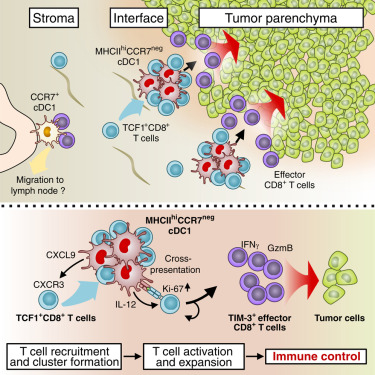
Mechanism for protective anticancer immunity
DESCRIPTION
Type 1 conventional dendritic cells (cDC1) can support T cell responses within tumors but whether this determines protective versus ineffective anti-cancer immunity is poorly understood. Here, we use imaging-based deep learning to identify intratumoral cDC1-CD8+ T cell clustering as a unique feature of protective anti-cancer immunity.
These clusters form selectively in stromal tumor regions and constitute niches in which cDC1 activate TCF1+ stem-like CD8+ T cells. We identify a distinct population of immunostimulatory CCR7neg cDC1 that produce CXCL9 to promote cluster formation and cross-present tumor antigens within these niches, which is required for intratumoral CD8+ T cell differentiation and expansion and promotes cancer immune control.
Similarly, in human cancers, CCR7neg cDC1 interact with CD8+ T cells in clusters and are associated with patient survival. Our findings reveal an intratumoral phase of the anti-cancer T cell response orchestrated by tumor-residing cDC1 that determines protective versus ineffective immunity and could be exploited for cancer therapy.